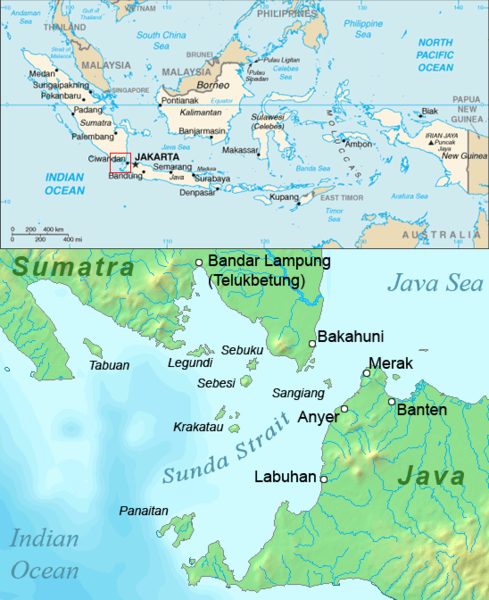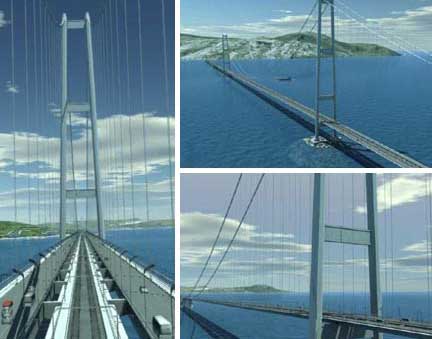Sunda Strait Bridge
The Sunda Strait Bridge is a planned road and railway megaproject between the two Indonesian islands of Sumatra and Java. The bridge starts from the idea of â€&lsqauo;â€&lsqauo;Prof. Sedyatmo, a professor at the Institut Teknologi Bandung in 1960 called Tri Nusa Bimasakti, which means the link between the three islands: Sumatra, Java and Bali.Construction of the bridge would be an ambitious project, being much more expensive than any other single infrastructure investment yet carried out in Indonesia. If the project goes ahead as planned, it would join the list of the world's most expensive transport infrastructure.
The project, with an initial estimated minimum cost of at least US$10 billion but probably considerably more, is for a series of bridges carrying a six lane highway and double track railway traversing the three islands of Prajurit, Sangiang, and Ular in the strait. The upper structure with a span of 3,300 meters would be like the Messina Strait Bridge in Italy, while the lower structure with a span of 1,991 meters would be similar to the Akashi KaikyÅ Bridge in Japan. Officials in the consortium that plan to build the bridge originally hoped that construction would begin in 2012 but even the plan to prepare a feasibility study was delayed beyond 2012. It is currently hoped that a feasibility study will be prepared in 2013. There were originally hopes are that that the 1st travellers might cross the bridge as early as 2020 although the likely completion date is tending to drift because of delays in discussions about plans for the project.
There are different views as to the most appropriate design for the details of the bridge, and even as to whether the construction of a bridge is the best way of easing the current serious transport bottlenecks for movement between Java and Sumatra. Alternatives which some observers favour are the construction of a tunnel or, more simply, improvements to the existing intensively-used ferry services.
A BBC news report in June 2010 put the estimated cost at $20bn and suggested that construction may start as early as 2011.
The bridge, included as part of a planned Sumatra economic corridor in the Indonesian government's 2011-2015 Masterplan released in May 2011, is listed as the single largest project in the plan. Details provided in the Masterplan indicate that the bridge is planned to be part of the Sunda Straits National Strategic Area and is part of the overall plan to improve connectivity across Indonesia. The Masterplan provides the following additional details as an outline of the project.
It isn't yet clear how such expensive infrastructure would be paid for. The Indonesian government has said that much of the cost will need to be financed through private sector participation. This reflects the current interest in Indonesia in the use of Public Private Partnerships for investments in infrastructure. One possibility is for the bridge to be financed through a "turn-key project" arrangement. Other options include the offering of shares in the project through an initial public offering (IPO) or establishing a backdoor listing through a company already listed on the stock exchange. There has also been discussion of various tax concessions that might be provided by the Indonesian Government (such as exemptions from import taxes and value-added tax) to facilitate the project.
There have been numerous reports of possible financial support from various governments and firms although no firm arrangements have been announced. Countries, banks and investors who have expressed interest include the Japanese, Chinese and Korean governments, and the GS Engineering and LG group, the JG Corporation (Japan), Nippon Koei and Nippon Steel (Japan), China Railway Construction Corporation and the China Development Bank (China), and the U.S. Export-Import (Exim) Bank.
The project isn't without its critics. Some commentators have argued that the funds could be better used for other urgent infrastructure projects. Others have argued that overall policies relating to interisland transport are more important than the construction of the bridge. Concerns voiced about the project have focused on both technical aspects and economic and financial matters. Few public details have yet been released by the Indonesian Government about these matters. A thorough cost-benefit analysis isn't yet available. A well-informed public discussion has therefore not yet been possible. The Indonesian government's Agency for the Assessment and Application of Technology has sponsored a number of preliminary discussions about aspects of the possible bridge technology in recent years. Some of the difficult technical, financial and economic issues involved in the construction of the Channel Tunnel between the United Kingdom and France appear to be relevant for planning about the best arrangements for a transport connection across the Sunda Strait. Demand forecasts for the use of the Chunnel Tunnel, for example, turned out to be far too optimistic thus leading to a benefit shortfall. The result was that revenues received through the operation of the tunnel were much less than expected during the 1st few years of operation.
Access to and use of land for infrastructure activities often gives rise to disagreements in Indonesia. Some concerns have already been expressed about land issues in connection with the project.
A 2nd set of technical issues concerns the geological risks involved in locating such a major project close to sites of possible volcanic activity. The Krakatoa island group, for example, is nearby.
A 3rd set of concerns relates to whether it is best to build a bridge at all, or whether alternative approaches might be a better way of responding to the rapidly-growing demand for improved transport services across the strait.
Some commentators have expressed concerns about the high cost of the project. Other uncertain issues relate to financing, likely pricing and revenue policies (toll arrangements), likely demand for (use of) the facility, and the cost of compensation for land acquired during the course of construction. Tendering processes are also often a source of considerable controversy in Indonesia and so questions have been raised about the nature of the letting of competitive tenders for the bridge.
Proponents of the bridge point to various considerations in support of the project. The Governors of Banten and Lampung along with local business and community representatives argue that the bridge would have important regional development benefits. Other observers point to the stimulus that the construction of the bridge could provide to the development of technical engineering skills in Indonesia.
Related Sites for Sunda Strait Bridge
- Remembering 1942 | Australian War Memorial read Sunda Strait Bridge
- Sundaland read Sunda Strait Bridge


No comments:
Post a Comment